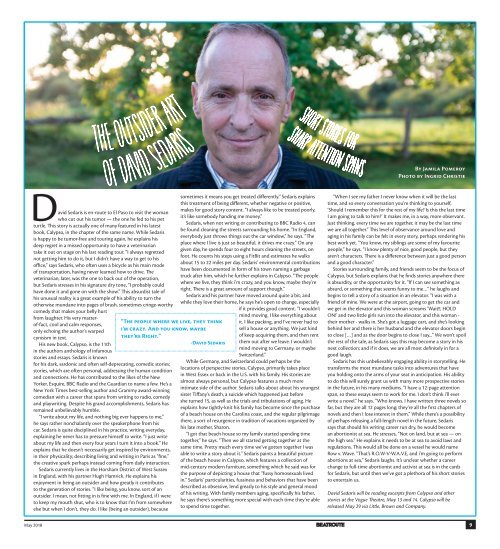BeatRoute Magazine BC Print Edition May 2018
BeatRoute Magazine is a monthly arts and entertainment paper with a predominant focus on music – local, independent or otherwise. The paper started in June 2004 and continues to provide a healthy dose of perversity while exercising rock ‘n’ roll ethics. Currently BeatRoute’s AB edition is distributed in Calgary, Edmonton (by S*A*R*G*E), Banff and Canmore. The BC edition is distributed in Vancouver, Victoria and Nanaimo. BeatRoute (AB) Mission PO 23045 Calgary, AB T2S 3A8 E. editor@beatroute.ca BeatRoute (BC) #202 – 2405 E Hastings Vancouver, BC V5K 1Y8 P. 778-888-1120
BeatRoute Magazine is a monthly arts and entertainment paper with a predominant focus on music – local, independent or otherwise. The paper started in June 2004 and continues to provide a healthy dose of perversity while exercising rock ‘n’ roll ethics.
Currently BeatRoute’s AB edition is distributed in Calgary, Edmonton (by S*A*R*G*E), Banff and Canmore. The BC edition is distributed in Vancouver, Victoria and Nanaimo. BeatRoute (AB) Mission PO 23045 Calgary, AB T2S 3A8 E. editor@beatroute.ca BeatRoute (BC) #202 – 2405 E Hastings Vancouver, BC V5K 1Y8 P. 778-888-1120
You also want an ePaper? Increase the reach of your titles
YUMPU automatically turns print PDFs into web optimized ePapers that Google loves.
The Outsider art<br />
of David Sedaris<br />
Short stories for<br />
sharp attention spans<br />
BY JAMILA POMEROY<br />
PHOTO BY INGRID CHRISTIE<br />
David Sedaris is en-route to El Paso to visit the woman<br />
who cut out his tumor — the one he fed to his pet<br />
turtle. This story is actually one of many featured in his latest<br />
book, Calypso, in the chapter of the same name. While Sedaris<br />
is happy to be tumor-free and touring again, he explains his<br />
deep regret in a missed opportunity to have a veterinarian<br />
take it out on stage on his last reading tour. “I always regretted<br />
not getting him to do it, but I didn’t have a way to get to his<br />
office,” says Sedaris, who often uses a bicycle as his main mode<br />
of transportation, having never learned how to drive. The<br />
veterinarian, later, was the one to back out of the operation,<br />
but Sedaris stresses in his signature dry tone, “I probably could<br />
have done it and gone on with the show.” This absurdist tale of<br />
his unusual reality is a great example of his ability to turn the<br />
otherwise mundane into pages of brash, sometimes cringe-worthy<br />
comedy that makes your belly hurt<br />
from laughter. His very matterof-fact,<br />
cool and calm responses,<br />
only echoing the author’s warped<br />
cynisism in text.<br />
His new book, Calypso, is the 11th<br />
in the authors anthology of infamous<br />
stories and essays. Sedaris is known<br />
“THE PEOPLE WHERE WE LIVE, THEY THINK<br />
I’M CRAZY. AND YOU KNOW, MAYBE<br />
THEY’RE RIGHT.”<br />
-DAVID SEDARIS<br />
for his dark, sardonic and often self-deprecating, comedic stories;<br />
stories, which are often personal, addressing the human condition<br />
and connections. He has contributed to the likes of the New<br />
Yorker, Esquire, B<strong>BC</strong> Radio and the Guardian to name a few. He’s a<br />
New York Times best-selling author and Grammy award-winning<br />
comedian with a career that spans from writing to radio, comedy<br />
and playwriting. Despite his grand accomplishments, Sedaris has<br />
remained unbelievably humble.<br />
“I write about my life, and nothing big ever happens to me,”<br />
he says rather nonchalantly over the speakerphone from his<br />
car. Sedaris is quite disciplined in his practice, writing everyday,<br />
explaining he never has to pressure himself to write. “I just write<br />
about my life and then every four years I turn it into a book.” He<br />
explains that he doesn’t necessarily get inspired by environments,<br />
in their physicality; describing living and writing in Paris as “fine,”<br />
the creative spark perhaps instead coming from daily interaction.<br />
Sedaris currently lives in the Horsham District of West Sussex<br />
in England, with his partner Hugh Hamrick. He explains his<br />
enjoyment in being an outsider and how greatly it contributes<br />
to the generation of stories. “I like being, you know, sort of an<br />
outsider. I mean, not fitting in is fine with me. In England, if I were<br />
to keep my mouth shut, who is to know that I’m from somewhere<br />
else but when I don’t, they do. I like (being an outsider), because<br />
sometimes it means you get treated differently.” Sedaris explains<br />
this treatment of being different, whether negative or positive,<br />
makes for good story content. “I always like to be treated poorly,<br />
it’s like somebody handing me money.”<br />
Sedaris, when not writing or contributing to B<strong>BC</strong> Radio 4, can<br />
be found cleaning the streets surrounding his home. “In England,<br />
everybody just throws things out the car window,” he says. “The<br />
place where I live is just so beautiful, it drives me crazy.” On any<br />
given day, he spends four to eight hours cleaning the streets, on<br />
foot. He counts his steps using a FitBit and estimates he walks<br />
about 15 to 22 miles per day. Sedaris’ environmental contributions<br />
have been documented in form of his town naming a garbage<br />
truck after him, which he further explains in Calypso. “The people<br />
where we live, they think i’m crazy, and you know, maybe they’re<br />
right. There is a great amount of support though.”<br />
Sedaris and his partner have moved around quite a bit; and<br />
while they love their home, he says he’s open to change, especially<br />
if it provides good content. “I wouldn’t<br />
mind moving. I like everything about<br />
it. I like packing, and I’ve never had to<br />
sell a house or anything. We just kind<br />
of keep acquiring them, and then rent<br />
them out after we leave. I wouldn’t<br />
mind moving to Germany, or maybe<br />
Switzerland.”<br />
While Germany, and Switzerland could perhaps be the<br />
locations of perspective stories, Calypso, primarily takes place<br />
in West Essex or back in the U.S. with his family. His stories are<br />
almost always personal, but Calypso features a much more<br />
intimate side of the author. Sedaris talks about about his youngest<br />
sister Tiffany’s death, a suicide which happened just before<br />
she turned 15, as well as the trials and tribulations of aging. He<br />
explains how tightly-knit his family has become since the purchase<br />
of a beach house on the Carolina coast, and the regular pilgrimage<br />
there, a sort of resurgence in tradition of vacations organized by<br />
his late mother, Sharon.<br />
“I got that beach house so my family started spending time<br />
together,” he says. “Then we all started getting together at the<br />
same time. Pretty much every time we’ve gotten together I was<br />
able to write a story about it.” Sedaris paints a beautiful picture<br />
of the beach house in Calypso, which features a collection of<br />
mid-century modern furniture, something which he said was for<br />
the purpose of depicting a house that “fussy homosexuals lived<br />
in.” Sedaris’ particularities, fussiness and behaviors that have been<br />
described as obsessive, lend greatly to his style and general mood<br />
of his writing. With family members aging, specifically his father,<br />
he says there’s something more special with each time they’re able<br />
to spend time together.<br />
“When I see my father I never know when it will be the last<br />
time, and so every conversation you’re thinking to yourself,<br />
‘Should I remember this for the rest of my life? Is this the last time<br />
I am going to talk to him?’ It makes me, in a way, more observant.<br />
Just thinking, every time we are together, it may be the last time<br />
we are all together.” This level of observance around love and<br />
aging in his family can be felt in every story, perhaps rendering his<br />
best work yet. “You know, my siblings are some of my favourite<br />
people,” he says. “I know plenty of nice, good people, but they<br />
aren’t characters. There is a difference between just a good person<br />
and a good character.”<br />
Stories surrounding family, and friends seem to be the focus of<br />
Calypso, but Sedaris explains that he finds stories anywhere there<br />
is absurdity, or the opportunity for it. “If I can see something as<br />
absurd, or something that seems funny to me…” he laughs and<br />
begins to tell a story of a situation in an elevator. “I was with a<br />
friend of mine. We were at the airport, going to get the car and<br />
we get in the elevator and this woman screams ‘Wait!!, HOLD<br />
ON!’ and two little girls run into the elevator, and this woman -<br />
their mother - walks in. She’s got a luggage cart, and she’s looking<br />
behind her and there is her husband and the elevator doors begin<br />
to close […] and as the door begins to close I say...” We won’t spoil<br />
the rest of the tale, as Sedaris says this may become a story in his<br />
next collection; and if it does, we are all most definitely in for a<br />
good laugh.<br />
Sedaris has this unbelievably engaging ability in storytelling. He<br />
transforms the most mundane tasks into adventures that have<br />
you holding onto the arms of your seat in anticipation. His ability<br />
to do this will surely grant us with many more prospective stories<br />
in the future, in his many mediums. “I have a 12-page attention<br />
span, so these essays seem to work for me. I don’t think i’ll ever<br />
write a novel.” he says. “Who knows. I have written three novels so<br />
far, but they are all 12 pages long; they’re all the first chapters of<br />
novels and then I lose interest in them.” While there’s a possibility<br />
of perhaps releasing a full-length novel in the future, Sedaris<br />
says that should his writing career run dry, he would become<br />
an abortionist at sea. He stresses, “Not on land, but at sea — on<br />
the high sea.” He explains it needs to be at sea to avoid laws and<br />
regulations. This would all be done on a vessel he would name<br />
Row v. Wave. “That’s R.O.W-V-W.A.V.E, and i’m going to perform<br />
abortions at sea,” Sedaris laughs. It’s unclear whether a career<br />
change to full-time abortionist and activist at sea is in the cards<br />
for Sedaris, but until then we’ve got a plethora of his short stories<br />
to entertain us.<br />
David Sedaris will be reading excerpts from Calypso and other<br />
stories at the Vogue Theatre, <strong>May</strong> 13 and 14. Calypso will be<br />
released <strong>May</strong> 29 via Little, Brown and Company.<br />
<strong>May</strong> <strong>2018</strong> 9


















